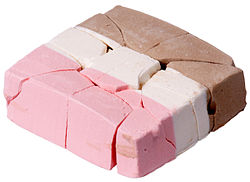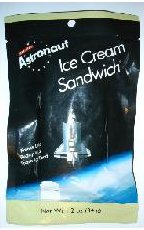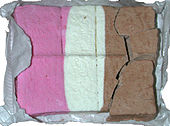Freeze-dried ice cream
 Freeze-dried Neapolitan ice cream | |
| Type | Ice cream |
|---|---|
| Created by | Whirlpool Corporation |


Freeze-dried ice cream, also known as astronaut ice cream or space ice cream, is ice cream that has had most of the water removed from it by a freeze-drying process, sealed in a pouch, and requires no refrigeration. Compared to regular ice cream, it can be kept at room temperature without melting and is more brittle and rigid, but still soft when bitten into. It was developed by Whirlpool Corporation under contract to NASA for the Apollo missions.[1][2] However, it was never used on any Apollo mission. Freeze-dried foods were developed so that foods could be sent on long-duration spaceflights, as to the Moon, and to reduce the weight of the water and oxygen normally found in food.[1]
Freeze drying (or lyophilization) removes water from the ice cream by lowering the air pressure to a point where ice sublimates from a solid to a gas. The ice cream is placed in a vacuum chamber and frozen until the water crystallizes. The air pressure is lowered, creating a partial vacuum, forcing air out of the chamber; next heat is applied, sublimating the ice; finally a freezing coil traps the vaporized water. This process continues for hours, resulting in a freeze-dried ice cream slice.[citation needed]
Freeze-dried ice cream is sold by mail order and is common in science museums and NASA visitor center gift shops, sometimes accompanied by other freeze-dried foods. They are also for sale in several physical camping stores like REI.[3]
Space use[]
Freeze-dried foods were developed for the Mercury missions.[4] Despite the common use of images of space walking astronauts in shuttle era space suits on packaging, freeze dried ice cream was not included on any Apollo, Skylab, Space Shuttle, or International Space Station missions.[5] According to one NASA food scientist, although freeze-dried ice cream was developed on request, "it wasn't that popular."[6] Astronaut Mike Massimino expressed dislike of freeze-dried ice cream, calling it "disgusting" and "more closely related to a building material than a food".[7]
Traditional ice cream in space[]
During the 1970s, astronauts ate regular ice cream on the Skylab space station and regular ice cream has also been eaten on the International Space Station.[8] Skylab had a freezer that was used for regular ice cream,[9] and occasionally Space Shuttle and International Space Station astronauts have taken regular ice cream into space.[10]
See also[]
References[]
- ^ Jump up to: a b "Space Food" (PDF). NASA. Archived from the original (PDF) on 2006-10-13. Retrieved 2007-06-07. The license is now not held by Action Products International, Inc.
- ^ "Astronaut Ice Cream". Archived from the original on January 27, 2011.
- ^ "Mountain House Neapolitan Ice Cream - Single Serving | REI Co-op". www.rei.com.
- ^ "Food in Space | National Air and Space Museum". airandspace.si.edu. Retrieved 2020-07-09.
- ^ "NASA Spinoff homepage". NASA. Archived from the original on 1997-06-07. Retrieved 2007-06-07.
- ^ "A Holiday Dinner in Space". NASA. December 15, 2005. Archived from the original on 2010-03-19. Retrieved 2009-08-13.
- ^ "Former NASA Astronaut Explains How Food Is Different in Space | WIRED". Youtube. WIRED Magazine. 16 July 2019.
- ^ "Space Today Online: Astronauts Eat in Orbit". www.spacetoday.org.
- ^ "History of Food in Space". NASA. Archived from the original on 2007-05-26. Retrieved 2007-06-07.
- ^ "Orbital Ice Cream, Atlantis' ISS Surprise". LiveScience.com. 2006-09-16. Retrieved 2007-06-07.
External links[]
- Dried foods
- Human spaceflight
- Ice cream
- NASA spin-off technologies
